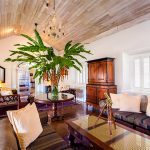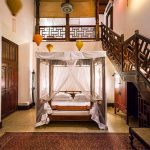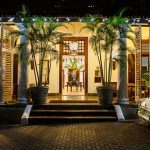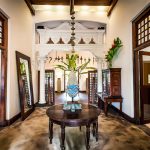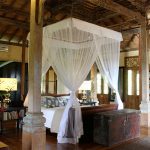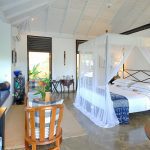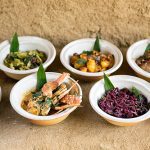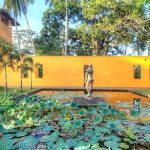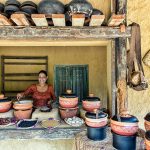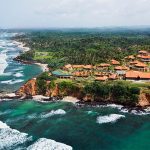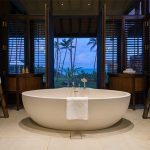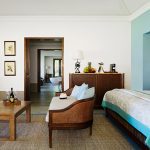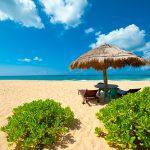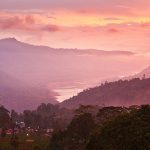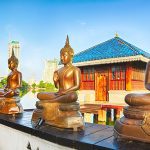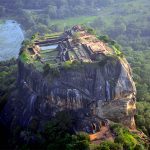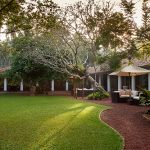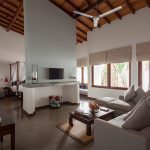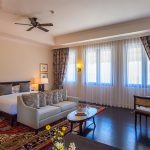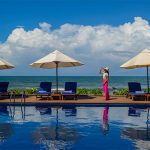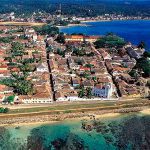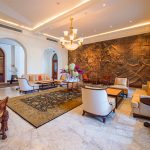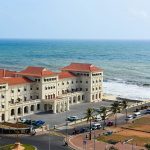Long regarded as one of the friendliest and most welcoming countries, Sri Lanka has managed to surmount the challenges of its recent past and is again high on the list of the world’s most rewarding travel destinations.
Sri Lanka
Long regarded as one of the friendliest and most welcoming countries, Sri Lanka has managed to surmount the challenges of its recent past and is again high on the list of the world’s most rewarding travel destinations. Extraordinary cultural attractions and scenic beauty may be enough for some people, but for travellers to whom the hotel experience is an integral part of their overall impression of the country, Sri Lanka offers many outstanding properties to cater to urbane visitors accustomed to high levels of quality and service.
Much of the focus of Sri Lanka’s tourist renaissance is on Galle Fort, the UNESCO World Heritage Site in the southwest of the country that is the oldest European settlement in Asia. First constructed by the Portuguese, commandeered by the Dutch, and taken over by the British, Galle Fort today is a microcosm of Sri Lanka’s history of European interaction. Charming buildings in decrepit condition a decade ago have been revitalised and transformed into smart boutiques, restaurants, and hotels. Australian Karl Steinberg, whose career in the film industry perhaps endowed him with the power of future vision, saw the potential among the ruins; he and his business partner Christopher Ong purchased the largest Dutch-era mansion in the fort and restored it to become Galle Fort Hotel, the most graceful of the small hotels that have since opened inside the fortress walls. Galle Fort Hotel’s simple façade on Church Street belies the spectacular style of the rooms and suites inside, glimpses of which are also seen in the airy public areas and the hotel’s restaurant. Galle Fort Hotel immediately became the darling of architectural magazines across the world and remains an inspiration in the restoration of historical properties in Sri Lanka and beyond. The atmospheric rooms of Galle Fort Hotel vary in size and style, but all of them present guests with memorable accommodation whether in the Porcelain Suite, the Chinese-influenced Admiral Cheng Ho Suite, or the traditional Grand Apartment where antique Dutch furniture recreates a sense of a bygone era in a spacious two-bedroom suite.
Once the precedent was set, other visionary foreigners came to Sri Lanka to open hotels. One of them is George Cooper, a British interior designer whose purchase of land away from the beach at the height of Sri Lanka’s civil war was seen as a folly at best and a disastrous investment at worst. Today, Mr. Cooper’s sublime hotel, Kahanda Kanda, is one of Sri Lanka’s most beautiful. Those twelve acres of land bought in 1999, located on a rise above Koggala Lake, are now worth a small fortune. To the front, the view of virgin jungle extends to the lake in the distance; behind the hotel, which is actually a series of individual cottages decorated with impeccable taste, is a working tea plantation. Exceptional among the accommodation options is the Dubu Suite, a Balinese house transported from its point of origin and reassembled to become the most private of Kahanda Kanda’s cottages, complete with its own park and swimming pool. Kahanda Kanda is well known among Colombo’s elite for its excellent meals and it is not at all unusual for city dwellers to take a drive for lunch looking over the jungle; the toasted coconut ice cream alone is well worth the journey. No visit to Sri Lanka, the world’s biggest tea exporter, is complete without a visit to a tea plantation. The Handunugoda tea estate next to Kahanda Kanda is an interesting excursion to marvel at the antique equipment meticulously maintained and still in use in preparing the delicate leaves for auction.
One of the great joys of visiting Sri Lanka is enjoying the excellence of Sri Lankan cuisine, absolutely delicious in its use of local ingredients that include the many herbs and spices so highly coveted by European merchants centuries ago. Despite the global awareness of international cuisines in the modern world, Sri Lankan food has somehow slipped under the radar and remains something of an unknown quantity outside the country, which makes the discovery of the many nuances of curry and desserts all the richer an experience once in the country. That fine food is found all over the country, but one town over from Kahanda Kanda is another extraordinary hotel with a gifted kitchen, this one owned by three stylish Swedes who gave up successful careers at home to start a new one as hoteliers. Thomas, Patrick, and Vadim are the men (and the initials) behind The Three By TPV, one of Sri Lanka’s most stylish places to stay. Not luxurious yet very fashionable, The Three By TPV is very white?white floors, white walls, white linens?and this (absence of) colour serves as a fine backdrop to the splashes of bright colour accenting the decor. The extraordinarily handsome staff here are nearly invisible in their perfection of service, at once delicate and attentive. The young resident chef is a talent in the making; the many tasting dishes of his Sri Lankan meals are a delight to the palate.
The Three By TPV is located on a small hill in Ahangama, near the beach but not on it. The hotel’s pool, also white, is used for fashion shoots; Thomas is very active in Galle Fashion Week and the artistic types from Colombo and abroad love the look of The Three inside and out. A separate property, Green Turtle Villa, is a very large, fully staffed private home on the beach in Kosgoda (just north of Galle) managed by The Three by TPV. One of the most glamorous places to stay in the whole country, the expansive house features four bedrooms, an enormous living and dining room, a media room, and a private beach.
More classic in style is one of Sri Lanka’s most patrician resorts, Cape Weligama. Occupying a private promontory on one of the country’s most scenic stretches of coastline, Cape Weligama is the premier accommodation option for visitors to Sri Lanka’s beautiful south coast seeking a stay in comfort and luxury balanced with warmth of both the sun and the sunny disposition of the Sri Lankan people. This special blend comes about thanks to local ownership, management, and staff who are as eager to please their guests as they are proud to represent their nation’s culture of welcoming visitors to its shores, as it has done for centuries.
Other splendid blends at Cape Weligama are enjoyed at their finest during high tea. Owned by the famous tea company Dilmah, Cape Weligama is the second of the company’s properties in its Resplendent Ceylon portfolio of exceptional destination experiences. Following the success of Ceylon Tea Trails, a resort high in the tea plantations where Sri Lanka’s leading export is grown, Dilmah opened Cape Weligama in 2014 to cater to sophisticated travellers who wanted to enjoy one of the country’s famous beaches in the south. A former coconut plantation is now home to only 40 rooms and suites set on well-manicured grounds with views of the Indian Ocean. Room sizes range from the very generously proportioned junior suites and master suites, favoured by families for their interconnecting doors, to individual villas, here called residences, in studio or one-bedroom configurations built in small clusters of two, three, or four around a swimming pool. A very few two-level residences have two units within the same building, creating the possibility of a two-bedroom unit with living room and private swimming pool?not on the ground, but on the first floor.
An all-inclusive resort, Cape Weligama takes great pride in its culinary experiences; extensive menus at breakfast, lunch, and dinner offer a superb selection of Western and Eastern dishes. Sri Lankan cuisine is generally unfamiliar to foreigners, but the multitude of flavours wins them over instantly with a single mouthful of a local dish expertly prepared by a team of chefs who see to it that every meal is an extraordinary experience. Here on the island of spices long known to the world as Ceylon, cinnamon, cardamom, cashews, and other local products are combined to make the most satisfying of dining sensations.
Taking full advantage of its spectacular location, Cape Weligama’s Beach Club arranges water activities such as snorkelling, diving, sailing, and sunset cruises as well as whale-watching excursions. Thanks to the proximity of a deep ocean trench to the south coast of Sri Lanka and the abundant nutrients flowing into the sea from the country’s freshwater rivers, this is one of the few places in the world where whales can be observed twelve months a year. Land-based activities such as the popular afternoon cycling routes through the tranquil countryside and visits to Udawalawe National Park where elephants, leopards, and a host of other exotic flora and fauna dwell in the dense forest.
Not all of Sri Lanka’s best hotels are in the south of the country; in fact, the queen of Sri Lanka’s hotels is found in its largest city. In the tradition of historical, colonial-era hotels found in Southeast Asia such as Raffles, The Eastern & Oriental, and The Majestic, Galle Face Hotel embodies the European presence in Sri Lanka in a single building. After recent renovations to public rooms and private accommodation, Galle Face Hotel has reclaimed its status as the ne plus ultra of Colombo hotels. With chic decor perfectly balancing the components of its vibrant heritage, the hotel’s lobby, restaurants, and bar area evoke times past, best seen in the hotel’s in-house museum, where the Duke Of Edinburg’s first automobile, purchased while he was an army officer in what was then known as Ceylon, commands attention in its own exhibition room. Though mostly appreciated for its traditions, including the bagpipe player who accompanies the lowering of the flag each evening, it is Galle Face Hotel’s oceanfront location that makes it equally appealing for guests who like to lie by the water and relax.
For a more fully beach-oriented stay, the newly opened Heritance Negombo is a dazzling addition to the Sri Lanka hotel scene. A large resort with impeccably high standards, the breezy rooms with floor-to-ceiling glass walls bring the outdoors inside to share the sumptuously appointed interiors, fine dining experiences, and some of the most obliging staff. Heritance Negombo is the latest addition to the Heritance Hotel Groups portfolio of properties across the country and is certain to be a favourite among travellers wanting accommodation convenient for late arrivals or early departures at Colombo’s Bandaranaike International Airport.
Another hotel near the airport is The Wallawwa, a former private estate turned superb hotel where croquet is played on the lawn and croquettes are served on the patio next to it. The Wallawwa is one of the most expensive hotels in Sri Lanka, but just try getting a room in this small property, such is the demand among guests eager to be looked after with the utmost of professionalism. The word ‘wallawwa’ means manor house in Sinhalese, and that is exactly the feel of this place where privacy and service are provided in tranquil surroundings.
Sri Lanka is a fascinating country for visitors, but with so many attractions spread throughout the island, it can be hard to see them all in a limited period of time. Thanks to the efficient services of Cinnamon Air, travellers to the land of rubies and sapphires need not make tough choices with regard to seeing the fascinating historical sites of the Cultural Triangle, relaxing on the beaches along the south coast, or breathing the cool scented air of the tea estates high in the hills of the interior.
As the only domestic airline in Sri Lanka, Cinnamon Air provides vital services for business and leisure travellers looking for convenience and efficiency in their transport around the country. Though road distances appear short when measured in kilometres, drive times in Sri Lanka are generally long and slow as drivers are faced with the challenges presented by a constant barrage of buses, trucks, cars, tuktuks, bicycles, pedestrians, dogs, cows, and roadworks that can make time in the car simultaneously colourful and tedious. In its own small terminal at Colombo’s Bandaranaike International Airport, Cinnamon Air welcomes passengers to the type of flight experience long since written off by travellers now habituated to arriving hours before the scheduled departure time to face the subliminally stressful check-in, document control, and security procedures before spending time waiting to board the plane. None of this happens at Cinnamon Air, where the flight is more like a family adventure than anything else. In fact, it is indeed possible for families and private groups to charter a Cinnamon Air aircraft for single flights or full itineraries around the island to see the best of Sri Lanka in the most time-efficient manner.
When deciding between a seven-hour drive or a 30-minute flight, the choice is obvious. The company’s use of seaplanes on several routes provides not only fun in flying but also an unrivalled level of personalised service. Cinnamon Air’s scheduled service to Sigiriya provides great views of the famous Lion Rock from above; private charters can combine a sightseeing flyover with other destinations around the country to make for a spectacular and memorable excursion over one day or several.
The Sri Lanka Tourism website is a helpful source of information about the many attractions in this country richly endowed with cultural attractions, natural beauty, and a general feeling of welcome in a place thankfully removed, at least a bit, from an ever more stressful world. On the efforts by the government to boost tourism, Ms. Madubhani Perera, Director Marketing of Sri Lanka Tourism Promotion Bureau commented, “The Civil War which was continuously in operation for 25 years in the North and East of Sri Lanka ended in mid 2009. From 2009 to 2013 the country was at its resettlement stage after the massive destruction. In 2013, the country invited tourists to visit this peaceful destination by organizing the 23rd Commonwealth Heads of Government Meeting in Sri Lanka which cleared pathways to invest on this beautiful island while inviting the world to visit us with the theme of Refreshingly Sri Lanka, Wonder of Asia. The Five-year (2011-2016) Tourism Development strategy aimed for positioning Sri Lanka as a model tourist destination benefitting from the country’s natural advantages of having the highest bio diversity in Asia backed by a strong culture, historic artefacts, exotic beaches, green environment and friendly people. As a result, Sri Lanka Tourism was able to bring 1.2 million tourists which receipted around US$ 1.7 billion contribution to the National GDP. As for 2016, we are now reaching our goal of attracting 2.2 million tourists this year.”
On the outlook for the next few years, she commented, “Sri Lanka Tourism expects to achieve an overall target of 4.5 million tourists by end 2020. We will set new arrival targets for specific markets according to the strategy considering the domestic infrastructure and environmental sustainability plans of the country. Sri Lanka receives tourists from various parts of the world; India and China has become the first two source markets while the country is mostly favored by Western Europe (UK, Germany and France), the traditional European markets. Apart from that there is a growing trend in attracting tourist from Scandinavia, Benelux and Australia. In the South East Asian region, there is a potential in Singapore, Malaysia, Philippines and South Korean markets.”
She added, “Between the food, people, culture, wellness and natural beauty, the People factor is very strong in Sri Lanka. Sri Lankan people own a warm and friendly nature which is reflected from their genuine smiling faces and enthusiasm to help those unfamiliar with aspects of local life.”
Subscribe to the latest edition now by clicking here.
If you would like to comment on this story or anything else you have seen on World Travel Magazine, head over to our Facebook page or message us on Twitter.
And if you liked this story, subscribe to our bi-monthly World Travel Magazine, a handpicked selection of editorial features and stories from Global Destinations, Inspire Me, Insider, Style File, Wellness & Travel, City Travel, Suite Life, At Leisure, Short Breaks and much more.


